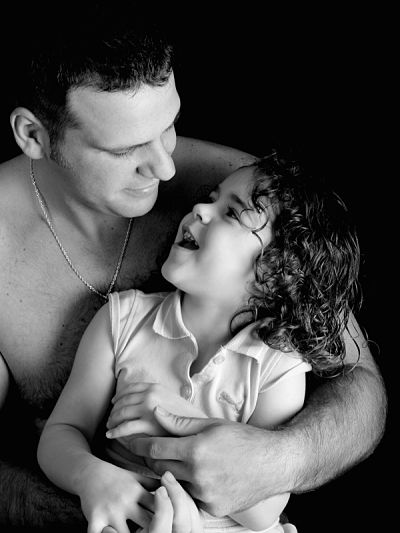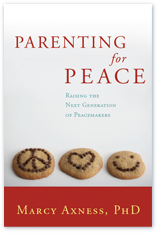[Excerpted from Parenting for Peace: Raising the Next Generation of Peacemakers, by Marcy Axness, PhD]
Connection and Conscience: The Foundations of Peace
Whenever a heinous, violent act is committed, there is talk of a lack of conscience in the perpetrator. The question of what builds a conscience has long engrossed philosophers, psychologists, and even Disney imagineers (who decided Pinocchio’s conscience looks a little like a cockroach, carries a watch fob and goes by the name of Jiminy Cricket). James Prescott’s massive, cross-cultural study of the root causes of violence, together with the body of bonding and attachment research, point clearly to the fact that conscience is seeded in the nurturing, pleasurable physical and emotional connection of a baby and his mother. It’s inescapable mammalian biology: in their poetic bestseller A General Theory of Love, the authors — three psychiatrists — explain that mammals who grow up in the absence of the coordinating influence of limbic regulation are “jagged and incomplete.” Central to this incompleteness is the missing foundation for the development of the entire suite of peacemaker capacities—including the basis of what we would call “conscience.”
Childhood trauma expert Bruce Perry simplifies the layered neuropsychological process linking bonding, attachment and conscience to this simple calculus: People = Pleasure. When bonding and attachment unfold as nature intends, the connection between a mother and her baby remains unbroken after birth; she reliably tends to her baby’s cries and coos in an engaged, responsive way, and delights in his delight, and he comes to associate her with all that is good. Mama = Pleasure. This association lays the foundation for the child, over the course of the critical first three years, to internalize myriad more complex associations as a foundation for a healthy self (“I’m effective in the world,” “I can trust others to be there for me,” “I make people happy,” and so on), and also for his brain to eventually hardwire the broader association, People = Pleasure. It is this People = Pleasure association that underlies civilized behavior.
But here’s what seems to be the rub: before people can equal pleasure, there must be one person (usually the mother) whose consistent loving, sensitive care becomes associated, over the course of the first nine months or so, with the reducing of distress and the experience of pleasure. This is a critical first step and prerequisite for the child later extrapolating positive associations and empathy to others. Trying to skip this step is one big way in which we’ve thrown hefty monkey wrenches into Nature’s elegant design: we let ourselves be lulled into the industrialist notion that we could substitute and rotate humans and get an equally good result. In many ways we’ve applied a factory model to childrearing: we thought that as long as a person had the right skills, he or she was interchangeable with a baby’s mother.
And in our defense, the mechanisms by which any particular mother could be so noninterchangeable have been unfathomable to us until the recent advent of brain imaging technology, and the field of attachment neurobiology that has made such informative use of that technology. We now know that there are dozens, maybe hundreds, of neurophysiological dimensions according to which a baby’s mother is unique and utterly irreplaceable to him — at least if we want him to flourish in growth mode and develop to his optimal potential. As Perry and coauthor Maia Szalavitz write in Born for Love:
“Just anyone” with hands, food, and clean diapers won’t do.…This intensely tight bond rarely extends to more than one person—and will only extend even partially to others if those folks have been with the baby pretty much every day.…Secondary caregivers like Dad or Grandma or a big sister might do for a while, but Mama is who they really want. Fathers often feel rejected by the strong preference that babies show for their mothers at [eight to nine months of] age and feel as though they’ve failed when they can’t soothe them. But this is just a normal stage in the development of attachment, which gradually grows to accommodate more people as the child’s brain becomes ready for this complexity.
Indeed, the complexity and scope of a child’s relationships is designed to sequentially expand the Mama = Pleasure association into a more intricate repertoire including ever more people, step by step. A child who is securely attached to his parents is deeply motivated to behave in harmony with them, which cultivates more pleasure all around; this becomes a positive feedback loop within the child that gradually expands outward to include the wider world in the category of “those who matter to me.”
Pleasure association into a more intricate repertoire including ever more people, step by step. A child who is securely attached to his parents is deeply motivated to behave in harmony with them, which cultivates more pleasure all around; this becomes a positive feedback loop within the child that gradually expands outward to include the wider world in the category of “those who matter to me.”
And that is conscience.
If we try to rush a child into this complexity by depriving her of what Perry and Szalavitz term the “intensive, particularized adult attention and affection” provided through a one-on-one attachment relationship, and instead subject her to an overly large or inconsistent rotation of caregivers as an infant, we cultivate a stunted social intelligence. Rather than the roots of conscience, what we see is the machinations of raw survival wit. An extreme example of this is seen in many children adopted out of overseas orphanages, and the indiscriminate friendliness they exhibit toward complete strangers. This is a pseudo-friendliness rooted not in authentic human connection but in the self-protective drive of What can you do for me? I believe that there are shades of this “What’s in it for me?” motivation lurking in the relationships of far more of us than we’d like to admit — especially those who missed out on the fullness of that particularized Mama-is-pleasure experience as an infant. For Generation Peace to gain traction toward changing the world in a healing direction, people must not be a means to an end.
For Generation Peace, people must be pleasure.
Excerpted from Parenting for Peace: Raising the Next Generation of Peacemakers, by Marcy Axness, PhD; pgs. 220 – 223.
Image:
Lisa Pflaum, used with permission
Tags: attachment, conscience, empathy, pleasure, social intelligence


